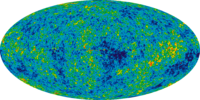- Cosmic variance
-
For the weblog, see Cosmic Variance (blog).
Physical cosmology 
Universe · Big Bang
Age of the universe
Timeline of the Big Bang
Ultimate fate of the universeEarly universeExpanding universeComponentsCosmic variance is the statistical uncertainty inherent in observations of the universe at extreme distances. It is based on the idea that it is only possible to observe part of the universe at one particular time, so it is difficult to make statistical statements about cosmology on the scale of the entire universe,[1][2] as the number of observations (sample size) must be too small.
Contents
Background
The standard big bang model is usually supplemented with cosmic inflation. In inflationary models, the observer only sees a tiny fraction of the whole universe, much less than a billionth (1/109) of the volume of the universe postulated in inflation. So the observable universe (the so-called particle horizon of the universe) is the result of processes that follow some general physical laws, including quantum mechanics and general relativity. Some of these processes are random: for example, the distribution of galaxies throughout the universe can only be described statistically and cannot be derived from first principles.
Philosophical issues
This raises philosophical problems: suppose that random physical processes happen on length scales both smaller than and bigger than the horizon. A physical process (such as an amplitude of a primordial perturbation in density) that happens on the horizon scale only gives us one observable realization. A physical process on a larger scale gives us zero observable realizations. A physical process on a slightly smaller scale gives us a small number of realizations.
In the case of only one realization it is difficult to draw statistical conclusions about its significance. For example, if the underlying model of a physical process implies that the observed property should occur only 1% of the time, does that really mean that the model is excluded? Consider the physical model of the citizenship of human beings in the early 21st century, where about 30% are Indian and Chinese citizens, about 5% are American citizens, about 1% are French citizens, and so on. For an observer who has only one observation (of his/her own citizenship) and who happens to be French and cannot make any external observations, the model can be rejected at the 99% significance level. Yet the external observers with more information unavailable to the first observer, know that the model is correct.
In other words, even if the bit of the universe observed is the result of a statistical process, the observer can only view one realization of that process, so our observation is statistically insignificant for saying much about the model, unless the observer is careful to include the variance. This variance is called the cosmic variance and is separate from other sources of experimental error: a very accurate measurement of only one value drawn from a distribution still leaves considerable uncertainty about the underlying model. Variance is normally plotted separately from other sources of uncertainty. Because it is necessarily a large fraction of the signal, workers must be very careful in interpreting the statistical significance of measurements on scales close to the horizon.
In physical cosmology, the common way of dealing with this on the horizon scale and on slightly sub-horizon scales (where the number of occurrences is greater than one but still quite small), is to explicitly include the variance of very small statistical samples (Poisson distribution) when calculating uncertainties.[3] This is important in describing the low multipoles of the cosmic microwave background and has been the source of much controversy in the cosmology community since the COBE and WMAP measurements.
Similar problems
A similar problem is faced by evolutionary biologists. Just as cosmologists have a sample size of one universe, biologists have a sample size of one fossil record. The problem is closely related to the anthropic principle.
Another problem of limited sample sizes in astronomy, here practical rather than essential, is in the Titius–Bode law on spacing of satellites in an orbital system. Originally observed for the solar system, the difficulty in observing other solar systems has limited data to test this.
References
- ^ Somerville et al.; Lee, Kyoungsoo; Ferguson, Henry C.; Gardner, Jonathan P.; Moustakas, Leonidas A.; Giavalisco, Mauro (2004). "Cosmic Variance in the Great Observatories Origins Deep Survey". The Astrophysical Journal Letters 600 (2): L171–L174. arXiv:astro-ph/0309071. Bibcode 2004ApJ...600L.171S. doi:10.1086/378628. http://www.iop.org/EJ/article/1538-4357/600/2/L171/17416.html.
- ^ M.S. Keremedjiev (Cornell University) (2006). "Quantifying the Effects of Cosmic Variance Using the NOAO Deep-Wide Field Survey". 37 #4. American Astronomical Society. http://www.aas.org/publications/baas/v37n4/aas207/1366.htm. Retrieved September 18, 2007.
- ^ Portsmouth, Jamie (2004). Analysis of the Kamionkowski-Loeb method of reducing cosmic variance with CMB polarization. Department of Astrophysics, Oxford / Smithsonian/NASA Astronomy Abstract Service. arXiv:astro-ph/0402173. Bibcode 2004PhRvD..70f3504P. doi:10.1103/PhysRevD.70.063504.
Sources
- Stephen Hawking (2003). Cosmology from the Top Down. Proceedings of the Davis Meeting on Cosmic Inflation.
External links
Cosmic microwave background radiation (CMB) Discovery of CMB radiation · List of CMB experiments · Timeline of CMB astronomy Effects Cosmic variance · Diffusion damping · Sachs–Wolfe effect · Sunyaev–Zel'dovich effect · Recombination · Thomson scattering
Full-sky temperature map taken by NASA's Wilkinson Microwave Anisotropy Probe (WMAP)Space-based
experimentsBalloon
experimentsGround-based
experimentsCategories:- Physical cosmology
- Statistical deviation and dispersion
Wikimedia Foundation. 2010.

